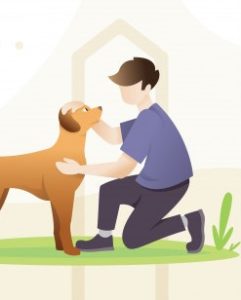How Do You Clicker Train Your Dog?
When to use a clicker:
The click should happen when the correct behavior occurs. If you cue your dog to sit, click when the bum hits the ground, and then produce the reward. Every click gets a reward, even if it’s accidental(if the dog never knows when a treat is coming, the clicker sound loses importance to the dog)! The click tells the dog a reward is on it’s way, and the bum hitting the ground was exactly what was desired. If, for instance, you simply said “good dog” when your dog sits, in that amount of time the dog may have sat but also cocked his head and lifted a paw. You may also be very tired from a rough day so when you say “good dog” you say it in a very unenthusiastic way. While most dogs learn sit anyway because it is a very natural behavior for them, you can imagine that the harder the behavior gets, the more a neutral and short “click” can aid in understanding. It is the same every time, and very precise. You also have a 30 second window between click and reward delivery, so your hands can be free if needed.
Pairing with rewards:
The click = reward. But what reward? Rewards should be viewed as a paycheck. If you are offered 50 cents for an activity you wanted to do anyway, such as watching your favorite show, this is no big deal and you might take it. But imagine being asked to work an 8 hour day helping customers for 50 cents. Most of us would laugh and walk away. Why would anyone take the second offer? The same concepts apply to our dogs. For easy behaviors that they want to do, being given verbal praise and a scratch is fine. But if I am teaching a behavior that is not immediately understood, being rewarded for the effort with a favorite snack can keep the learner happy to put in the effort. What is most rewarding also differs by dog. One individual might prefer chicken above all else, while another prefers cheese. Try different dog-safe food offerings to find your dog’s favorites. An example of a treat hierarchy might be:
- Every day dog kibble
- Everyday dog kibble mixed with shredded cheese
- Diced Hot dogs and string cheese mixed with kibble
- Pepperoni
Advanced Uses:
Once both dog and handler are accustomed to clicker mechanics, a new world has opened to you both. This is a world where you can click everything you like and have it immediately offered again. You can click your dog for having a closed mouth instead of barking or click four feet on the floor instead of jumping. We can “shape” a new behavior by clicking approximations, which is how we move on to truly difficult behaviors. Both handler and dog learn to think creatively. The dog wants to know what will earn a click, and the handler can learn to look for the good “clickable” behaviors rather than being pre-disposed to punish undesirable behaviors. These techniques can even be applied across species! Human surgeons and gymnasts have been coached with clickers. Fish have been taught to swim through hoops. Dogs have been taught to count.
The End Game:
Does that mean if you start training with a clicker you are stuck using treats and this tool forever? No! These are simply tools to use when you want to teach a new behavior or clean up an old one (we all get a little sloppy sometimes). A dog can offer a well-known behavior simply to please their handler. Positive reinforcement builds a strong bond between handler and animal, so the pleasure of working together may be enough (think back to the example of watching your favorite show). What happens if you lose your clicker? You can substitute marker words such as “yes” or good while training. While less precise, using a word to mark the right behavior does work.
- If concerned about your dog’s weight, consider measuring out half of the amount of kibble for a meal, mixing a second equal half of chicken, and having them earn a really good breakfast.
- A behavior is considered fluent when it can be performed consistently in multiple locations. Until then, consider keeping a clicker handy.
- Happy clicking!

